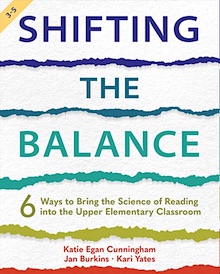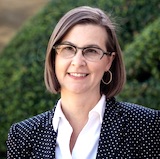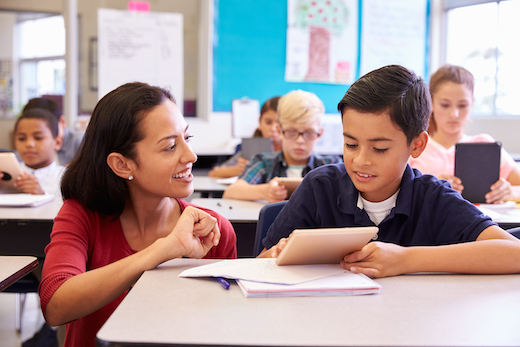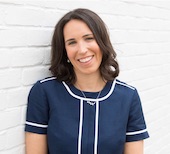Shifting the Balance with Headwork and Heartwork
The authors of Shifting the Balance (Grades 3-5) invite literacy educators in the upper elementary and early middle grades to “engage in both the headwork and the heartwork required to ensure our practices are science-aligned and student-centered.”
By Jan Burkins, Kari Yates and Katie Egan Cunningham
We (Jan and Kari) have a confession to make.
We began exploring the science of reading for selfish reasons. We mostly wanted to be able to argue more effectively in attempts to defend our past teaching practices. We wanted to verify our own certainty about the wrongness of the criticisms that were being launched at balanced literacy practices, which had become targets of the “reading war,” erupting anew. We were certain that critics were misunderstanding, misinterpreting, and misrepresenting many of the practices we held dear.
But what happened along the way has been profoundly different than what we expected. In writing the Shifting the Balance books, we have been humbled, reeducated, and transformed. Our understanding of how reading begins and develops has evolved as well, as we have endeavored to support you as you help children grow into people who can (and want) to read.
Yet, as profound as the technical or “head work” of learning more about reading science has been for most of us, initiating and maintaining momentum for the shifts we need to make takes more than just scienc-y stuff.
Alongside the “head work,” most of us also have to make space for some “heart work.” We inevitably have to grapple with the vulnerability, uncertainty, and emotional exertion that comes with realizing that some of our practices may have been making learning to read harder for children.
In fact, we wrote The Six Commitments (you can download a free poster here) to help create the kinds of safe spaces that are needed for this work of honest appraisal, revision, and replacement of current practices to take place. And it is with these Six Commitments in mind that we invite you to join us in this messy and ongoing heart work, shifting from certainty to curiosity, from dismissiveness to listening, from judgment to vulnerability, from all-or-none to nuanced thinking, and from overwhelm (heads-in-the sand) to action.
Student outcomes won’t change unless adult practices change, and adult practices won’t change unless there is a safe space for examining “the problem” and owning the solutions.
Despite Best Efforts, Too Many Children Still Struggle with Reading and Writing
If you teach in the upper elementary grades, chances are you have some students who have truly taken off as readers and writers. Their skills grow steadily each day, along with their confidence. They devour whole series of books and read to learn about the topics that interest them, whether volcanoes, performing magic tricks, or taking care of a goldfish.
They write compelling pages to persuade or to entertain and are eager to share them. They take the lead in book clubs and are quick to jump into whole-class discussions. From reading while they wait for the bus, to excitedly telling friends that a favorite author has a new book coming out, to eating lunch quickly in order to have time to “run to the library,” they think of themselves as readers and writers and live into that literate identity.
But, if you’re like most teachers of upper elementary grade students, you also have some students, maybe even many, who keep you up at night. These are students who drag their feet when it’s time for independent reading. They guess at unknown words based on the first letter or bits and pieces of the word. They skip or misread whole syllables in multisyllabic words, reading “invention” for intention or “elible” for eligible. They spend much of their writing time staring at a blank page, and when they do get something down on paper, sentences are choppy and disconnected and sometimes don’t even make sense. What’s more, they have a lot of trouble with spelling, writing “goyn” for join and “wont” for want.
In some cases, their skills are splintered. For example, some have an impressive speaking vocabulary but considerable difficulty when it comes to decoding or spelling long words. Others have strong decoding skills, but when it comes to comprehension, it’s clear that their thinking is surface-level at best. By the time they reach your upper elementary classroom, many are working to make themselves invisible. And some even leverage a different bag of tricks – resistance, distraction, disruption – just hoping to survive what feels like another day filled with reading and writing failures.
It’s not that we haven’t been working hard to address the needs of students. But the truth is, some of our practices have actually complicated the process of learning to read rather than smoothing it out. Unfortunately, this adversely affects some groups of children more than others.
What’s more, the academic gaps between the haves and the have-nots just keep widening. The accumulated advantage for some and subsequent disadvantage for others, known as the Matthew Effect (Stanovich 1986), means that strong readers get stronger, and readers who have difficulty with reading get farther and farther behind.
Many educators – whether “balanced literacy” or “science of reading” proponents – are gravely concerned and committed to disrupting systems that perpetuate reading failures. Some science of reading advocates blame balanced literacy for inequitable literacy outcomes. And some balanced literacy advocates resist the science of reading for fear that it will make access to rich literacy experiences even more inequitable. We would argue that both of these concerns are valid and that neither should be dismissed.
All children, especially those locked into systems that seem to guarantee their failure (Minor 2018), need access to both the secrets of the alphabetic code and relevant experiences with texts. They need both explicit information about how reading works and immersive experiences that show them how to leverage reading and writing to change the world.
Fortunately, the more we learn, the better equipped we are to make thoughtful changes to practices that can serve all children. And the good news is that there is a whole lot of important science about how children learn to read that once consistently implemented in most reading classrooms – while also holding onto our commitment to powerful experiences with worthwhile texts – will enable more children than ever before to lead literate lives.
But What About Students Beyond the Beginning Stages of Reading?
Shifting the Balance K-2 was dedicated to sharing some critical shifts to practice in the early literacy classroom, where the methodology for reading instruction has been most fiercely debated. The first book was designed to clear up misunderstandings about current practices that might actually be making learning to read harder, rather than easier.
We wanted to share with teachers what we had come to understand ourselves about how the human brain learns to read from the inside out. Our goal was to offer teachers foundational knowledge they could use to provide more science-aligned instruction, basing decisions more on research than on intuition, assumptions, past practices, hunches, or opinions.
But what about readers beyond second grade? And what about K-2 students who are making strong progress as readers? These are some of the questions that were on Katie Egan Cunningham’s mind when she approached us in March of 2021 with the idea of collaborating on a second Shifting the Balance 3-5 book.
Katie had also taken a deep dive into reading science. As a teacher with years of experience in the upper elementary grades, a college professor, a literacy consultant, and even the mother of an elementary and a middle school reader herself, Katie was particularly driven to understand the ways reading science could be leveraged for older readers.
Having read our first book, she expressed curiosity and energy for exploring with us how to help teachers address the unique needs of developing readers in light of reading science. We, too, were interested in readers beyond the earliest stages. And knowing Katie both as a human being and as the author of a book about bringing the science of happiness into the classroom (Cunningham 2019), we knew she would have a lot to offer the project.
In fact, truth be told, our book would never have happened without Katie’s initial nudge and subsequent insights, not to mention her hard work and passion for this project.
While it’s true that the most heated debates about instructional methods seem to have focused on the earliest grades, there is plenty of confusion and uncertainty about practices with older students, too. And more recently, there is growing concern that excessive attention to explicit phonics in the early grades will eventually result in older readers who don’t comprehend well (Wexler 2022). So, as a writing team, the three of us settled on an essential guiding question: How do we address the widening gaps between students in the upper elementary grades?
In response to that question, the shifts we offer hold promise for students who have moved past the “beginning to read” phase and are learning to read with increasing accuracy, automaticity, purpose, and joy. Still, as any writers do, we had to make some hard choices about what to include and what to leave out. We’ve done our best to distill more than forty years of empirical research into a book that feels accessible and manageable. We’ve also tried to write the kind of book that you can look forward to reading on a Sunday afternoon on the couch, but that also gives you actionable steps that can make a difference for your students on Monday morning.
Navigating Complex and Competing Tensions
The truth is that, although debates in the field are often presented as “this vs. that”– phonics vs. meaning, knowledge vs. strategies, science vs. joy, structured literacy vs. balanced literacy – decisions about reading instruction are more complex than they are binary.
But the opportunity for all of us, as a community of literacy educators, is to listen past the noise to hear the signal. We can lean into the dissonance of competing tensions with an open mind, an open heart, and a critical look at the research. For example, as a 3-5 educator, you are probably wrestling with challenges like these:
- Selecting complex texts for knowledge building while also making sure students get word-reading practice that reinforces their developing proficiency.
- Building foundational reading skills while also making instructional decisions that consider children’s identities and interests.
- Planning for explicit vocabulary instruction while also making the most of in-the-moment opportunities to develop word consciousness – all without dampening enthusiasm for texts and words.
- Offering independent reading practice opportunities that are motivating and engaging while also getting students to do the hard work of stretching into texts that will grow them as readers.
- Teaching important reading comprehension strategies without making reading all about comprehension strategies.
- Leaning into the power of rereading while also making fluency practice authentic and meaningful for students.
- Giving students choices in their reading while also supporting students in reading things they need to read but may not be thrilled about.
- Filling the gaps for students who have fallen “behind” in reading while also making sure that those who are “on track,” or even “ahead,” move forward, particularly when they need to demonstrate the same grade-level skills on standardized tests.
Our goal is to share a path forward that embraces both science and balance, applying content knowledge and pedagogy to translate research into practice. We believe Shifting the Balance offers a clear introduction to what the research says on six topics critical to the upper elementary and early middle grades classroom while also providing simple but high-leverage teaching moves you can make starting immediately.
We invite you to join us as we engage in both the headwork and the heartwork required to ensure our practices are science-aligned and student-centered.
Read an authors Q&A at The Six Shifts blog.

Dr. Jan Burkins is a full-time consultant and author of six books for literacy educators. With more than 30 years of experience in education, Jan’s favorite work is conducting literacy audits and working with schools and district leaders to determine their next steps for making learning to read easier for the children they support.
Kari Yates is an author, speaker, and consultant with a passion for helping busy literacy educators thrive. Her experiences include classroom teacher, special education, Reading Recovery teacher, elementary principal, and district literacy coordinator. Kari is the author of several other literacy-related titles for teachers.
Dr. Katie Egan Cunningham is passionate about children’s rights to joyful, purposeful, evidence-based literacy learning. Katie loves working with students, teachers, and school leaders to bridge the science of reading with the joy of learning. Katie is a former elementary classroom teacher and instructional coach who now supports teachers as a college professor and educational consultant. She is the author of Start with Joy: Designing Literacy Learning for Student Happiness.

































